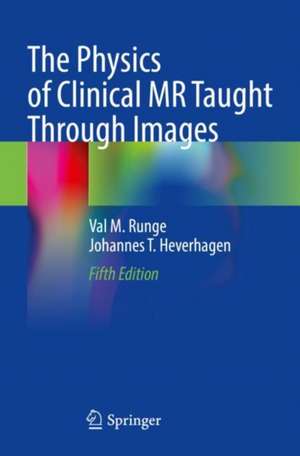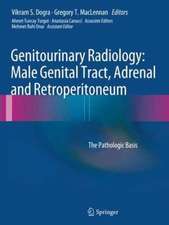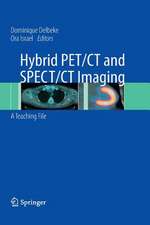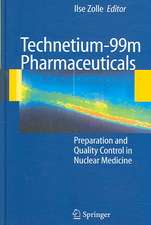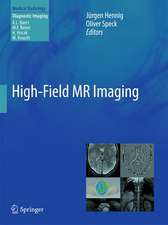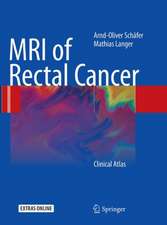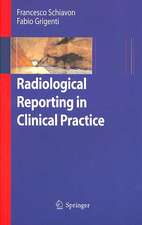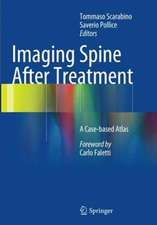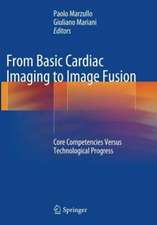The Physics of Clinical MR Taught Through Images
Autor Val M. Runge, Johannes T. Heverhagenen Limba Engleză Paperback – 22 mai 2023
The objective of this 5th edition of the book, as with the prior editions, is to teach through images a practical approach to magnetic resonance (MR) physics and image quality. Unlike other texts covering this topic, the focus is on clinical images rather than equations. A practical approach to MR physics is developed through images, emphasizing knowledge of fundamentals important to achieve high image quality. Pulse diagrams are also included, which many at first find difficult to understand. Readers are encouraged to glance at these as they go through the text. With time and repetition, as a reader progresses through the book, the value of these and the knowledge thus available will become evident (and the diagrams themselves easier to understand).
The text is organized into concise chapters, each discussing an important point relevant to clinical MR and illustrated largely with images from routine patient exams. The topics covered encompass the breadth of thefield, from imaging basics and pulse sequences to advanced topics including contrast-enhanced MR angiography, spectroscopy, perfusion and advanced parallel imaging/data sparsity techniques. Discussion of the latest hardware and software innovations, for example next generation low field MR, deep learning, MR-PET, 7 T, interventional MR, 4D flow, CAIPIRINHA, spiral techniques, radial acquisition, simultaneous multislice, compressed sensing and MR fingerprinting, is included because these topics are critical to current clinical practice as well as to future advances. Included in the fifth edition are a large number of new topics, keeping the text up to date in this increasingly complex field. The text has also been thoroughly revised to include additional relevant clinical images, to improve the clarity of descriptions, and to increase the depth of content.
The book is highly recommended for radiologists, physicists, and technologists interested in the background of image acquisition used in standard as well as specialized clinical settings.
The book is highly recommended for radiologists, physicists, and technologists interested in the background of image acquisition used in standard as well as specialized clinical settings.
| Toate formatele și edițiile | Preț | Express |
|---|---|---|
| Paperback (1) | 550.21 lei 38-44 zile | |
| Springer International Publishing – 22 mai 2023 | 550.21 lei 38-44 zile | |
| Hardback (1) | 751.73 lei 3-5 săpt. | +42.82 lei 4-10 zile |
| Springer International Publishing – 22 mai 2022 | 751.73 lei 3-5 săpt. | +42.82 lei 4-10 zile |
Preț: 550.21 lei
Preț vechi: 579.17 lei
-5% Nou
Puncte Express: 825
Preț estimativ în valută:
105.32€ • 114.44$ • 88.52£
105.32€ • 114.44$ • 88.52£
Carte tipărită la comandă
Livrare economică 18-24 aprilie
Preluare comenzi: 021 569.72.76
Specificații
ISBN-13: 9783030854157
ISBN-10: 3030854159
Pagini: 373
Ilustrații: XVI, 373 p. 388 illus., 79 illus. in color.
Dimensiuni: 155 x 235 x 21 mm
Greutate: 0.74 kg
Ediția:5th ed. 2022
Editura: Springer International Publishing
Colecția Springer
Locul publicării:Cham, Switzerland
ISBN-10: 3030854159
Pagini: 373
Ilustrații: XVI, 373 p. 388 illus., 79 illus. in color.
Dimensiuni: 155 x 235 x 21 mm
Greutate: 0.74 kg
Ediția:5th ed. 2022
Editura: Springer International Publishing
Colecția Springer
Locul publicării:Cham, Switzerland
Cuprins
Section I. Hardware.- Section II. Basic Imaging Physics.- Section III. Basic Image Acquisition.- Section IV. Advanced Image Acquisition.- Section V. Flow.- Section VI. Tissue-.- Section VII. Artifacts, Including Those Due to Motion, and the Recluction Thereof.- Section VIII. Further Improving Diagnostic Quality, Technologic Innovation.- Section IX Recent Innovations.- Section X Appendix.
Recenzii
“The book remains a comprehensive text, with good quality image reproduction. With the addition of the new section the content is reasonably up to date. … this book … is a good reference book if you want to see clinical examples of a particular concept.” (Martin Graves, RAD Magazine, September, 2023)
Notă biografică
Val Murray Runge is an American and Swiss professor of radiology and the editor-in-chief of Investigative Radiology. He was one of the early researchers to investigate the use of gadolinium-based contrast agents for magnetic resonance imaging (MRI), giving the first presentation in this field (in 1982), followed two years later by the first presentation of efficacy (in 1984). His research also pioneered many early innovations in MRI, including the use of tilted planes (for standardization of brain imaging, in 1987) and respiratory gating (for liver imaging, in 1984). His publication on multiple sclerosis in 1984 represented the third and largest clinical series (to that date) investigating the role of MRI in this disease, and the first to show characteristic abnormalities on MRI in patients whose CT was negative.
Runge graduated from Stanford University with a bachelor of science, with honors, in Chemistry in June 1978. He subsequently received his MD from Stanford University School of Medicine in 1982. Following completion of a diagnostic radiology residency at Vanderbilt University Medical Center in 1985, Runge was appointed as assistant professor and chief of service of magnetic resonance at Tufts University School of Medicine in Boston in 1986. In 1990 he was appointed professor of diagnostic radiology and biomedical engineering, Director of the Magnetic Resonance Imaging and Spectroscopy Center, and the Rosenbaum Endowed Chair of Diagnostic Radiology, at the University of Kentucky Medical Center. In 2002, Runge was appointed the Robert and Alma Moreton Centennial Chair in Radiology, Scott & White Memorial Hospital, and professor of radiology at the Texas A&M Health Science Center. In 2010 he was appointed the John Sealy Distinguished Chair and Professor of Radiology at the University of Texas Medical Branch in Galveston. Runge then spent two years in Zurich, Switzerland as a visiting professor at the University Hospital of Zürich(2013-2015). Runge lives currently in Zurich, Switzerland, having a long-term appointment as a professor and member of the faculty at Inselspital, Universitätsspital Bern. He received the title of Prof. Dr. from the University of Bern in 2019.
He is an author of more than 230 peer-reviewed papers published in the scientific literature. He is also the editor for nineteen medical textbooks, with several of these translated into other languages, including German, Chinese, Polish and Turkish. He has given more than 800 scientific and invited presentations at national and international meetings and medical schools across North America, Europe, Australia, Japan, Korea and China over the past 38 years.
Johannes T. Heverhagen is a German and Swiss professor of radiology and the chair of the University Institute of Diagnostic, Interventional and Pediatric Radiology of the Inselspital, University Hospital of the University of Bern, Switzerland.
His research has focused on the technical and clinical development of MRI. He pioneered quantitative approaches in MRI and enabled translation of emergency CT investigations to MRI. He has also focused on the safe and efficient application of Iodine and Gd based contrast agents in diagnostic and interventional radiology. His work investigated the effect of contrast agents and DNA double strand breaks as well as short- and long-term effects of the retention of contrast agents.
Heverhagen graduated from the University of Kaiserslautern, Germany with a master of science in Physics in March 1997. He subsequently received his PhD and MD from the University Marburg, Germany in 2004 and 2007 respectively. In 2006, he was appointed as Assistant Professor for Medical Physics at the University of Marburg. Following completion of a diagnostic radiology residency at the University of Marburg in 2009, he was appointed as assistant professor and research director of the Department of Radiology at the University of Marburg. From 2002 until 2006, Heverhagen spent four years as a research scientist at the Department of Radiology at the Ohio State University. In 2006, he was appointed as adjunct professor of radiology at the Ohio State University. In 2010, he was appointed as Vice Chair of Radiology at the University of Marburg. In 2012, he was appointed as Chair of the University Institute of Diagnostic, Interventional and Pediatric Radiology of the Inselspital, University Hospital of the University of Bern, Switzerland.
He is an author of more than 190 peer-reviewed papers published in the scientific literature. He is also the author of eleven book chapters in medical textbooks, with several of these translated into other languages, including German and Polish. He has given more than 200 scientific and invited presentations at national and international meetings and medical schools across North America, Europe, and Australia over the past 22 years.
He is an author of more than 230 peer-reviewed papers published in the scientific literature. He is also the editor for nineteen medical textbooks, with several of these translated into other languages, including German, Chinese, Polish and Turkish. He has given more than 800 scientific and invited presentations at national and international meetings and medical schools across North America, Europe, Australia, Japan, Korea and China over the past 38 years.
Johannes T. Heverhagen is a German and Swiss professor of radiology and the chair of the University Institute of Diagnostic, Interventional and Pediatric Radiology of the Inselspital, University Hospital of the University of Bern, Switzerland.
His research has focused on the technical and clinical development of MRI. He pioneered quantitative approaches in MRI and enabled translation of emergency CT investigations to MRI. He has also focused on the safe and efficient application of Iodine and Gd based contrast agents in diagnostic and interventional radiology. His work investigated the effect of contrast agents and DNA double strand breaks as well as short- and long-term effects of the retention of contrast agents.
Heverhagen graduated from the University of Kaiserslautern, Germany with a master of science in Physics in March 1997. He subsequently received his PhD and MD from the University Marburg, Germany in 2004 and 2007 respectively. In 2006, he was appointed as Assistant Professor for Medical Physics at the University of Marburg. Following completion of a diagnostic radiology residency at the University of Marburg in 2009, he was appointed as assistant professor and research director of the Department of Radiology at the University of Marburg. From 2002 until 2006, Heverhagen spent four years as a research scientist at the Department of Radiology at the Ohio State University. In 2006, he was appointed as adjunct professor of radiology at the Ohio State University. In 2010, he was appointed as Vice Chair of Radiology at the University of Marburg. In 2012, he was appointed as Chair of the University Institute of Diagnostic, Interventional and Pediatric Radiology of the Inselspital, University Hospital of the University of Bern, Switzerland.
He is an author of more than 190 peer-reviewed papers published in the scientific literature. He is also the author of eleven book chapters in medical textbooks, with several of these translated into other languages, including German and Polish. He has given more than 200 scientific and invited presentations at national and international meetings and medical schools across North America, Europe, and Australia over the past 22 years.
Textul de pe ultima copertă
The objective of this 5th edition of the book, as with the prior editions, is to teach through images a practical approach to magnetic resonance (MR) physics and image quality. Unlike other texts covering this topic, the focus is on clinical images rather than equations. A practical approach to MR physics is developed through images, emphasizing knowledge of fundamentals important to achieve high image quality. Pulse diagrams are also included, which many at first find difficult to understand. Readers are encouraged to glance at these as they go through the text. With time and repetition, as a reader progresses through the book, the value of these and the knowledge thus available will become evident (and the diagrams themselves easier to understand).
The text is organized into concise chapters, each discussing an important point relevant to clinical MR and illustrated largely with images from routine patient exams. The topics covered encompass the breadth of the field, from imaging basics and pulse sequences to advanced topics including contrast-enhanced MR angiography, spectroscopy, perfusion and advanced parallel imaging/data sparsity techniques. Discussion of the latest hardware and software innovations, for example next generation low field MR, deep learning, MR-PET, 7 T, interventional MR, 4D flow, CAIPIRINHA, spiral techniques, radial acquisition, simultaneous multislice, compressed sensing and MR fingerprinting, is included because these topics are critical to current clinical practice as well as to future advances. Included in the fifth edition are a large number of new topics, keeping the text up to date in this increasingly complex field. The text has also been thoroughly revised to include additional relevant clinical images, to improve the clarity of descriptions, and to increase the depth of content.
The book is highly recommended for radiologists, physicists, and technologists interested in the background of image acquisition used in standard as well as specialized clinical settings.
The book is highly recommended for radiologists, physicists, and technologists interested in the background of image acquisition used in standard as well as specialized clinical settings.
Caracteristici
Provides a readily accessible tool for learning, leveraging, and mastering the powerful diagnostic capabilities of MRI Allows the comprehension of key MRI technology Explores nine systematically organized sections covering core topics
Descriere
Descriere de la o altă ediție sau format:
The objective of this 5th edition of the book, as with the prior editions, is to teach through images a practical approach to magnetic resonance (MR) physics and image quality. Unlike other texts covering this topic, the focus is on clinical images rather than equations. A practical approach to MR physics is developed through images, emphasizing knowledge of fundamentals important to achieve high image quality. Pulse diagrams are also included, which many at first find difficult to understand. Readers are encouraged to glance at these as they go through the text. With time and repetition, as a reader progresses through the book, the value of these and the knowledge thus available will become evident (and the diagrams themselves easier to understand).
The text is organized into concise chapters, each discussing an important point relevant to clinical MR and illustrated largely with images from routine patient exams. The topics covered encompass the breadth of the field, from imaging basics and pulse sequences to advanced topics including contrast-enhanced MR angiography, spectroscopy, perfusion and advanced parallel imaging/data sparsity techniques. Discussion of the latest hardware and software innovations, for example next generation low field MR, deep learning, MR-PET, 7 T, interventional MR, 4D flow, CAIPIRINHA, spiral techniques, radial acquisition, simultaneous multislice, compressed sensing and MR fingerprinting, is included because these topics are critical to current clinical practice as well as to future advances. Included in the fifth edition are a large number of new topics, keeping the text up to date in this increasingly complex field. The text has also been thoroughly revised to include additional relevant clinical images, to improve the clarity of descriptions, and to increase the depth of content.
The book is highly recommended for radiologists, physicists, and technologists interested in the background of image acquisition used in standard as well as specialized clinical settings.
The book is highly recommended for radiologists, physicists, and technologists interested in the background of image acquisition used in standard as well as specialized clinical settings.
